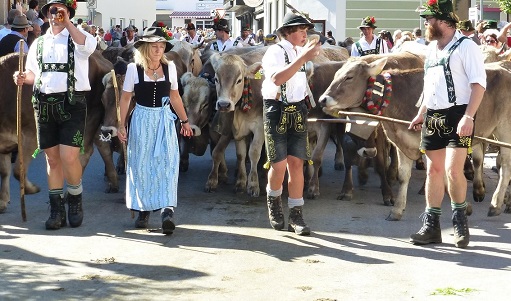
From the vibrant alpine folds of Bavaria to the hidden valleys of the Black Forest, Germany’s traditional clothing tells the story of centuries-old customs, regional pride, and cultural symbolism. Known broadly as Tracht, these garments are far more than folklore festival attire – they are living, wearable heritage.
In this guide, we’ll explore the fascinating world of traditional German dress. We’ll uncover how garments like the Dirndl and Lederhosen became cultural icons, trace the differences between regional costumes, examine modern revivals of old styles, and show why what Germans wear still reflects who they are.
This hub article links to four deep-dive spoke articles:
- ➡️ Dirndl Decoded: The Meaning Behind Germany’s Most Iconic Dress
- ➡️ Lederhosen Lore: From Peasant Gear to German Pride
- ➡️ Beyond Bavaria: Regional Costumes You’ve Never Heard Of
- ➡️ Modern Tracht: How Germans Are Redefining Traditional Fashion
Let’s begin where most visitors first encounter traditional German dress – Oktoberfest.
Tracht Today: More Than Beer Tent Costumes
Every year, millions flock to Oktoberfest in Munich wearing what they believe to be authentic Bavarian fashion: women in Dirndls, men in Lederhosen. But the origins of these clothes go much deeper than beer-fueled tourism.
Tracht (from the verb tragen, “to wear”) refers to any traditional folk clothing in Germany. What most people call “German clothing” is actually just one highly visible variant – the Bavarian kind. In reality, dozens of unique styles exist across the country, many still worn on holidays, weddings, and cultural events.
Tracht can signify everything from marital status to region of origin. Some villages even developed their own variations in embroidery, hats, and color codes.
The Dirndl: Alpine Grace with Hidden Codes
The Dirndl started as humble workwear for maids and farmers. Today, it’s a national symbol. But not all Dirndls are equal.
Classic Dirndls include:
- A white blouse
- A bodice (usually laced)
- A full skirt
- An apron tied in a specific way
Apron knots matter: tied on the left means single, on the right means taken, centered means a virgin, and in the back signals widowhood or waitstaff.
Over time, Dirndls have become more colorful, fitted, and ornate – especially in high-end fashion circles.
➡️ Deep dive: Dirndl Decoded: The Meaning Behind Germany’s Most Iconic Dress
Lederhosen: Utility Meets Identity
Once worn by peasants and hunters, Lederhosen were built to last – made of leather, often knee-length, with suspenders and decorated embroidery.
Lederhosen used to signal rural masculinity. Now they’re worn proudly at folk festivals and weddings, especially in Bavaria and Austria.
Variations exist: short vs. long pants, different leather types, and belt versus H-shaped suspenders. Each detail says something about where you’re from.
➡️ More insights: Lederhosen Lore: From Peasant Gear to German Pride
Beyond Bavaria: The Real Diversity of German Dress
Tracht exists far beyond Munich. Here’s a glimpse of lesser-known traditional German clothing:
- Black Forest (Schwarzwald): Women wear elaborate Bollenhut hats – large straw hats with red (single) or black (married) pompoms.
- Franconia: Embroidered vests and decorative bonnets, often in rich colors.
- Swabia: Conservative styles with dark fabrics and lace shawls.
- Saxony and Thuringia: Complex headdresses, known as Goldhauben, and intricate beading.
- North Germany: Maritime and Protestant simplicity – long dresses, caps, and dark colors.
Each costume reflects a mix of religious influence, agricultural role, and class distinction.
➡️ Full coverage: Beyond Bavaria: Regional Costumes You’ve Never Heard Of
Why Germans Still Wear Traditional Clothing
Contrary to stereotype, Tracht is not just a costume. In many towns, it’s worn proudly at church services, weddings, Schützenfeste (marksmen festivals), or Maibaum (Maypole) celebrations.
- Family traditions: Some outfits are passed down generations.
- Cultural preservation: Worn at Heimat festivals to assert identity.
- Regional pride: Tracht is often used to show loyalty to one’s village or valley.
Even tourists wearing Dirndls at Oktoberfest tap into a broader feeling: participating in something rooted in place and history.
Tracht in the Fashion World
In recent years, designers have reimagined traditional clothing for the runway:
- Adding silk and velvet to Dirndls
- Cutting Lederhosen slim like modern jeans
- Fusing urban minimalism with alpine embroidery
Fashion labels like Lena Hoschek, Gottseidank, and Lodenfrey are redefining what it means to dress “German.”
This movement isn’t just aesthetic – it ties into sustainability, slow fashion, and the search for authentic identity.
➡️ Learn more: Modern Tracht: How Germans Are Redefining Traditional Fashion
How to Wear Traditional German Dress Respectfully
If you’re not German but want to wear Tracht:
- Do some research. Know what region your outfit is based on.
- Avoid clichés. Cheap costumes with beer-printed aprons don’t reflect tradition.
- Respect the context. Weddings, cultural events, and festivals are appropriate settings.
- Ask locals. Many Germans are happy to help you wear it right.
Cultural Significance: More Than a Costume
Traditional German clothing expresses values:
- Continuity: Passed from generation to generation
- Community: Tied to specific towns and customs
- Craftsmanship: Hand-stitched and detailed
- Pride: A celebration of regional identity
In a globalized world, wearing Tracht is both nostalgic and revolutionary – it asserts local beauty in a fast-moving culture.
Clothing as Cultural Language
Traditional German clothing isn’t stuck in the past. It evolves with each generation, whether through grandma’s apron or a Berlin fashion week reinterpretation.
Each seam, ribbon, and bootlace has a story. Learning to read these stories helps us better understand the regions of Germany – not just on the map, but in the heart.
